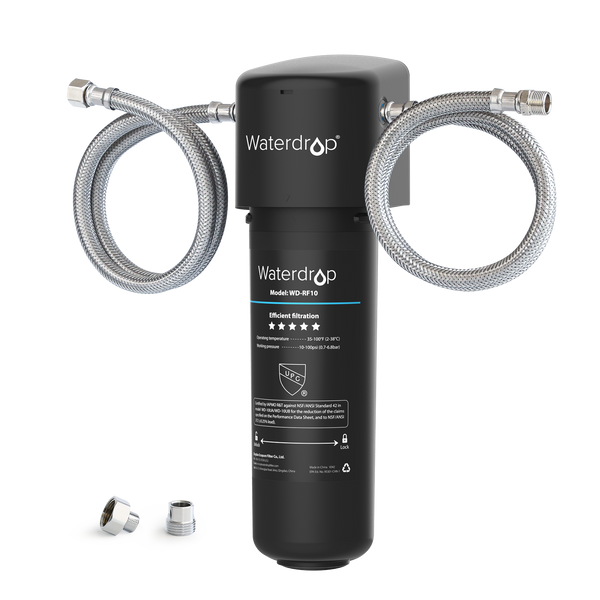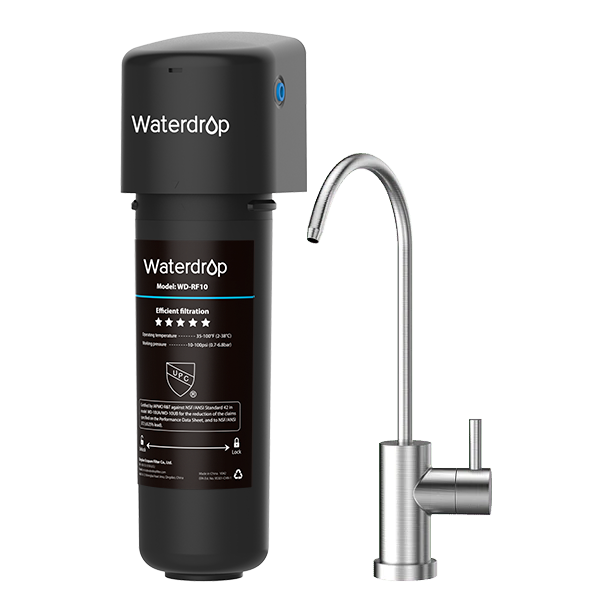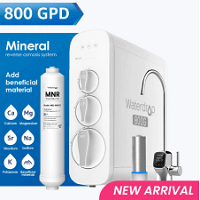How to Remineralize Reverse Osmosis Water?
by Dr. Jonathan Doyle - Updated May 08, 2023
Reverse osmosis is an advanced water filtration technology with increasing popularity in today’s market. It has a precise 0.0001-micron filtration capacity, which means it can effectively remove almost all the impurities in your drinking water. It delivers pure filtered water comprising only water molecules and no contaminants.
If you are looking for an effective purification solution for your water, you should strongly consider a reverse osmosis water filter, especially in regions with poor water quality.
The Operation Process of Reverse Osmosis Water Filter System
RO filters rely on the reverse osmosis process to carry out effective filtration. As the name suggests, reverse osmosis is the opposite of the traditional osmosis process. While osmosis happens naturally due to the movement of a solvent from a region of high concentration to a region of low concentration while passing through a permeable membrane, reverse osmosis is a forced process where the solvent molecules are pushed from a low-concentration region to a high-concentration region under hydrostatic pressure.
When the solvent (contaminated water) passes through the RO membrane, the membrane separates it into water molecules and other molecules. The other molecules are larger than the 0.0001-micron pore size of the RO membrane, which makes it impossible for them to pass through. These other molecules include bacteria and other contaminants in your tap water. However, it also includes beneficial materials like salts and minerals. That is why the filtered water from RO systems does not contain the minerals originally present in tap water.
Click to learn more about Does Reverse Osmosis Remove Bacteria and Viruses?
Essential Minerals in Drinking Water
Certain essential minerals and trace elements play crucial roles in the optimal functioning of the human body. These minerals come from water and contribute in various ways to the body’s overall immunity. Some of these elements and minerals include;
Calcium
- helps with the development of bones and teeth
- prevents illnesses like kidney stones, stroke, and hypertension
- helps prevent blood clotting and muscle contraction when present at optimum levels in the body
Magnesium
- protects the body from severe illnesses and heart problems
- contributes significantly to muscle regulation and nerve functioning
- helps maintain safe blood pressure and blood sugar levels
- helps with protein and DNA formation

Fluoride
- affects teeth health and strength
Sodium
- is crucial to effective blood pressure regulation
- ensures electrolyte balance and the effective functioning of nerves and muscles
Iron
- is necessary for transporting oxygen within the bloodstream
- can cause brown, yellow, or red stains on household fixtures, laundry, dishes, and glassware when present at a level higher than 0.3mg/L
- causes anemia in infants, children, and pregnant women due to deficiency
Copper
- contributes immensely to bone formation, immune system development and maintenance, infant growth, and others
How Do You Remineralize Reverse Osmosis Water?
The absence of the necessary microelements in RO water does not mean we should stop drinking it. The RO filtration process removes harmful contaminants like bacteria, viruses, and heavy metals from tap water. If you eat a strictly balanced diet and drink sufficient electrolytes after exercise, you wouldn’t have a problem. However, if you cannot supplement these micronutrients through a balanced diet and consumption of electrolytes, you may consider other ways to remineralize your RO drinking water.

Adopt A Remineralized RO System
The Waterdrop Reverse Osmosis System X12 offers a high-speed, tankless water filtration at an impressive 1200G with an 11-stage precision filtration mechanism, capable of removing contaminants such as lead, chlorine, and PFAS, while enhancing water with essential alkaline minerals like calcium and magnesium.
It not only improves health, taste of food and beverages, but can also alleviate stomach acid discomfort. Boasting a smart design, the system includes a digital faucet with functions such as precise water dispensing and TDS/filter lifespan monitoring. It's engineered for space-saving and simple DIY installation, re-mineralizing water to create natural-tasting, fresh, and healthy water accessible directly from your kitchen.
The easiest option to enjoy the benefits of mineralized water without missing out on effective RO filtration is to adopt a RO system with a remineralization filter. Unlike the regular RO water filters with three filtration stages, these models have an additional post-activated carbon filter or a remineralization filter that re-adds the minerals into the water and ensures a balanced pH.
Waterdrop G3P800 under-sink reverse osmosis system combines a robust 3-stage filtration process and a scale inhibitor to deliver premium filtered water with zero water scale accumulation. The remineralization filter can re-add 18 different natural materials to your drinking water. Drinking this filtered water extensively prevents chronic diseases and improves digestion and immunity.
Click to check the real customer review of Waterdrop G3P800 from Jason: https://www.trustpilot.com/reviews/63972cdeeb0ad848990852f3.
Add An Extra Remineralization Filter
For homeowners with an existing RO system, you can introduce a separate remineralization filter that completes the mineralization job perfectly. Waterdrop offers a remineralization filter compatible with most reverse osmosis water systems and under sink water filtration systems.
The filter is designed to restore 18 natural minerals, including calcium, magnesium, sodium, and others. The remineralized water from this filter can do much good for your body. What’s more, you can save 8300 single-used bottles and $12600 spent on bottled mineral water.
Introduce Mineral Salts
The body requires essential inorganic substances in small amounts for proper functioning, and these often come from mineral salts. These include iron, magnesium, potassium, sodium, and calcium. Although each element’s roles are specific, they all contribute to the overall optimal functioning of all parts of the human body, including the immune system, teeth, bones, muscles, nerves, etc.
Mineral salts should be added to water in proper dosages. Choosing the right mineral type and checking the possible chemical reactions is also important. The use of clean water is recommended to ensure maximum safety and effectiveness. Some common examples of mineral salts include magnesium sulfate, sodium chloride, and calcium carbonate.
Install Alkaline Water Pitchers
You can get alkaline pitchers that are designed to add beneficial minerals to water during filtration. These pitchers combine ion exchange resins with activated carbon to eliminate water contaminants and adjust the water’s pH level to attain more alkalinity. Therefore, trace amounts of minerals like potassium, magnesium, and calcium are present in the water from alkaline water pitchers. However, the exact minerals and the amount usually depend on the pitcher and filtration system in question.
Although you can use alkaline pitchers to mineralize water, they are unsuitable for remineralizing water from reverse osmosis or other filtration methods. The pitcher will add these minerals, but more is needed to compensate for the minerals lost during filtration.
What Are the Benefits of Remineralizing Filtered Water?
Although filtered water from reverse osmosis systems contains no toxic elements, it also lacks the essential minerals listed above.
It is vital for optimal body function.
Remineralizing your RO water can restore the lost essential elements during reverse osmosis filtration without adding impurities. Mineralized water contains major micronutrients, including calcium, magnesium, and other trace minerals. Calcium contributes to stronger teeth and bones, while magnesium is a co-factor and activator for over 300 enzymatic reactions in the body. The muscles and nerves in the body also require sodium to function effectively. Click here to learn the benefits of mineral water.
It has an improved flavor.
Most water drinkers can differentiate between the taste of reverse osmosis water and other types of water. This is due to the fact that RO water tastes unpleasant and bland. Conversely, the alkaline water with re-added minerals retains an improved and great taste. It also helps to overcome the craving for soda or juice.

It may help maintain healthy blood pressure.
Saline water contains high Sodium (Na+) levels, which may raise blood pressure. However, other minerals such as potassium (K+), calcium (Ca2+), and magnesium (Mg2+) are known to lower blood pressure. A 2019 study reported that people who consume mildly saline water exhibit lower blood pressure, potentially due to increased magnesium and calcium intake. However, it is essential to state here that certain types of mineral water are known to contain high sodium content. Such types of water can raise blood pressure due to increased blood volume and water retention.
It may ease constipation.
In a placebo-controlled study, people suffering from constipation were given natural mineral water to drink. Participants of the study consumed either 300mL or 500mL of mineral water or a placebo for six weeks. Bowel movements were monitored within this period, alongside stool consistency and similar symptoms. The results showed that participants who drank 500mL of natural mineral water recorded complete bowel movements improved stool consistency and an overall healthy body system. From this, we can associate mineral water consumption with easing constipation.
It encourages people to drink more water.
Drinking more water helps keep the body hydrated and reduces the frequency of thirst—the electrolytes in mineralized water help to quench thirst better and faster than regular filtered water. The flat and bland taste of RO water is due to its neutral pH, while the better taste of the remineralized water is due to its alkaline pH. The latter is perfect for drinking, cooking, and making tea, coffee, and other beverages. You are also more likely to drink more water if the taste is great, and the more water you drink, the more hydrated you are.
To Round Up
Drinking water with an adequate amount of minerals is necessary for humans to stay healthy. Such water also tastes better and is crispy. While this is not a call to abandon your RO water filtration systems, you should consider the addition of a separate remineralization water filter to your existing setup. That way, you can always get safe, filtered, mineralized water for drinking and cooking.
Recommended Reading:
Contaminants Detected in Fruitland Water
Special
Service District
30
Contaminants
EXCEED EWG HEALTH GUIDELINES
EXCEED EWG HEALTH GUIDELINES
30 Total Contaminants in Your Water
Water Provider
Fruitland Water Special Service DistrictPopulation Affected
120,000Water Source
Ground waterExceeds Guidelines
Others Detected

















